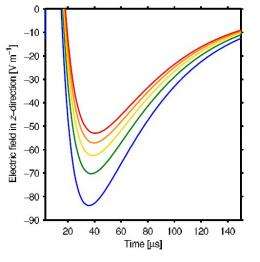May 13, 2010 report
Ball lightning may sometimes be explained as hallucinations

(PhysOrg.com) -- Physicists in Austria have calculated the magnetic fields associated with certain types of lightning strikes are powerful enough to create hallucinations of hovering balls of light in nearby observers, and that these visions would be interpreted as ball lightning.
The scientists, Alexander Kendl and Joseph Peer from the University of Innsbruck, analyzed electromagnetic pulses of repetitive lightning discharges and compared them to the magnetic fields used in clinical transcranial magnetic stimulation (TMS). Their results suggest the variable magnetic fields produced by lightning are in the same order of magnitude and frequency as those applied in TMS that stimulate hallucinations, such as balls of light known as cranial phosphenes. They postulate that balls of light known as ball lightning, which are occasionally reported during thunder and lightning storms, could often be hallucinations arising from lightning electromagnetic pulses affecting the brains of close observers.
Ball lightning was first reported in St. Petersburg in Russia in 1754 by a Dr. Richmann, who was attempting to copy Benjamin Franklin’s kite-lightning experiment, and who was instantly killed by the lightning. It is rarely seen and photographic evidence is almost nonexistent. There are dozens of theories of how ball lightning could form, including the burning of hot silicon particles produced when a lightning strike vaporizes the ground.
TMS is a non-invasive method of stimulating areas of the brain, and is used in psychiatric treatments and in studying the brain. It is known that when the visual cortex is stimulated by pulsed magnetic fields in TMS, patients will sometimes see hallucinations of luminous shapes in their visual field. With the stimulation coils attached to the head, the visions can occur with single or repeated pulses at frequencies of around 1-50 Hz. The cortical phosphenes appear as bubbles, lines, ovals or patches of either white or a variety of colors. When the stimulation coil is moved, the phosphenes also appear to move.
Rare but natural long (1-2 seconds) repetitive lightning strikes produce electromagnetic pulses, which the researchers thought might produce currents within the brain in the same order of magnitude in terms of duration, strength and frequency as in TMS in observers 20-100 meters away from the lightning strike. They calculated the time-varying electromagnetic fields of various types of lightning strikes for observers at various distances from the strike.
The calculations showed that only lightning strikes consisting of multiple return strokes at the same point over a period of seconds could produce a magnetic field long enough to cause cortical phosphenes. This type would account for around 1-5% of lightning strikes, but very few of these would be seen by an observer 20 to 100 m away, and of those the researchers estimate seeing the light for seconds would occur only in about one percent of unharmed observers. The observer does not need to be outside, but could be inside an aircraft or building. Kendl and Peer also said an observer would be most likely to classify the experience as ball lightning because of preconceptions.
More information: J. Peer, A. Kendl: Transcranial stimulability of phosphenes by long lightning electromagnetic pulses, arXiv:1005.1153v1 [physics.med-ph] arxiv.org/abs/1005.1153
© 2010 PhysOrg.com



















